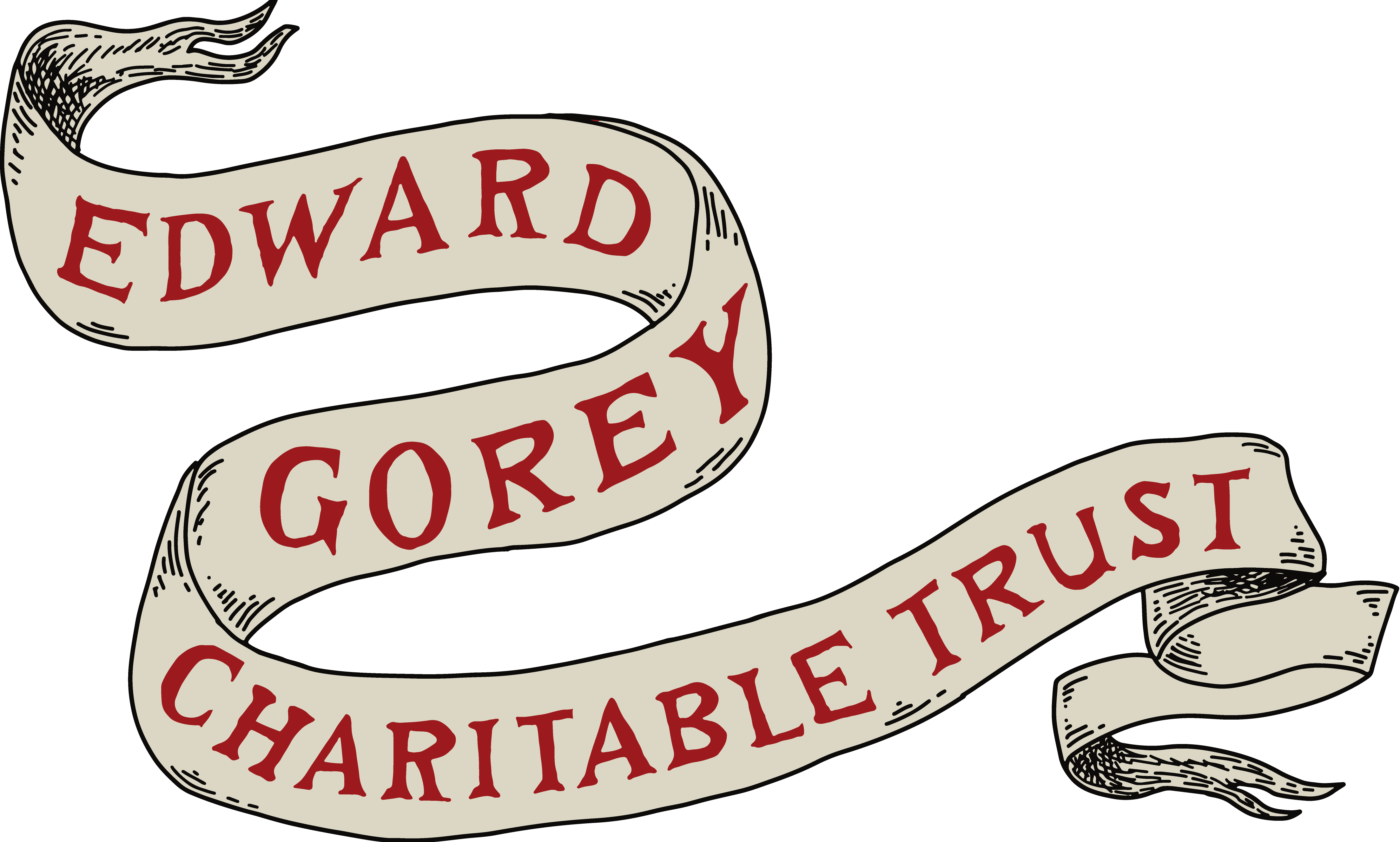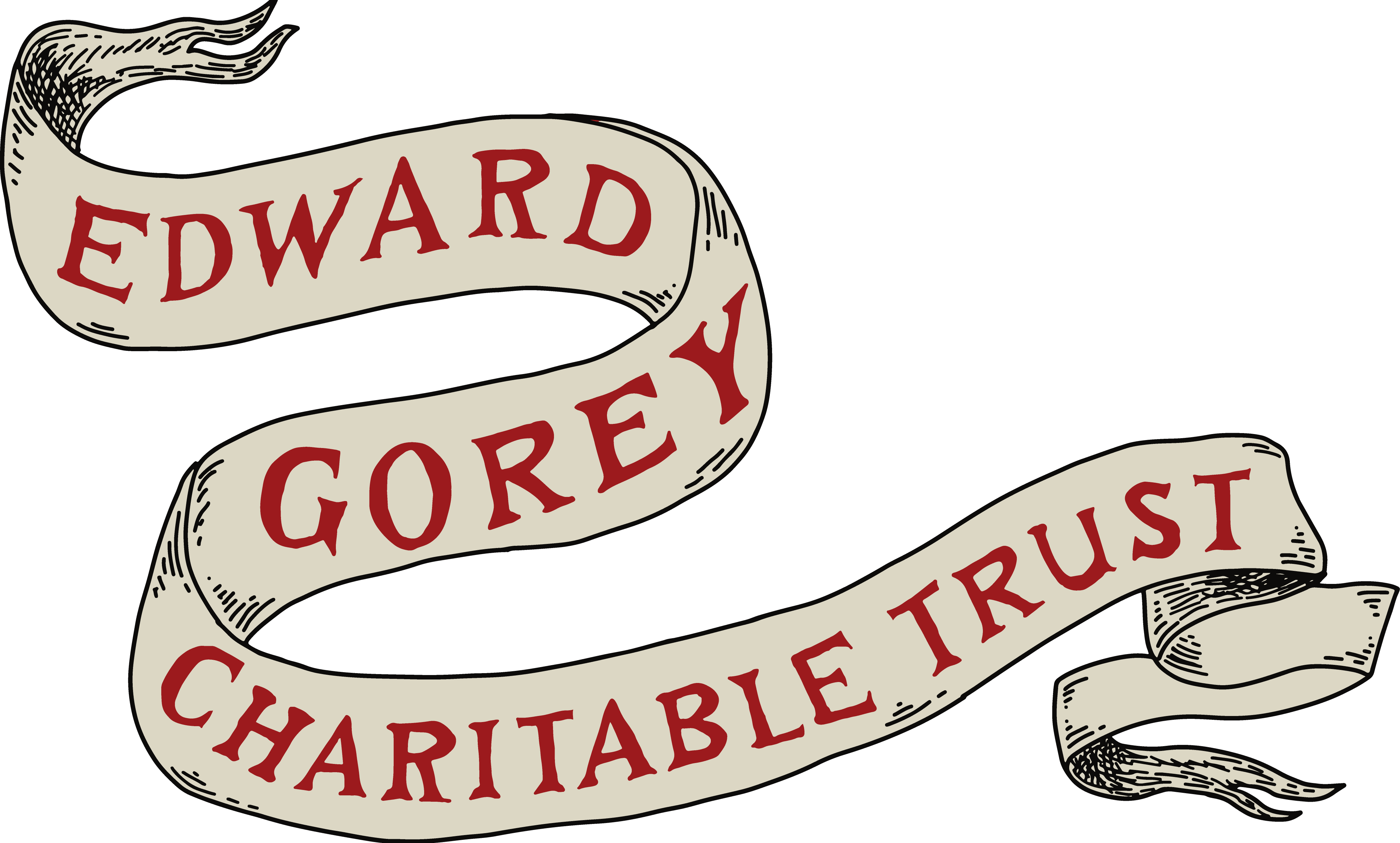Introduction to Gorey’s Black Doll
 The Black Doll runs throughout Edward Gorey’s life in word, picture, and beyond. The singular image had an innocent enough origin. According to Andreas Brown, bookseller and publisher of Gorey’s works “a lifelong friend of Gorey’s made the black cloth doll for him in 1942. Gorey visited her while she was making it, and upon seeing it insisted on keeping it in its unfinished state, lacking a face, arms, and clothing.”
The Black Doll runs throughout Edward Gorey’s life in word, picture, and beyond. The singular image had an innocent enough origin. According to Andreas Brown, bookseller and publisher of Gorey’s works “a lifelong friend of Gorey’s made the black cloth doll for him in 1942. Gorey visited her while she was making it, and upon seeing it insisted on keeping it in its unfinished state, lacking a face, arms, and clothing.”
A more detailed description occurs in the first edition of The Black Doll, A Silent Film: “a stuffed figure about eight-inches high made of black velvet. Its featureless head is shaped roughly like a football; it has a pear-shaped body, sausage-shaped legs, and no arms. (All the black dolls in the film, including the real one, indicated by capital letters, are indistinguishable from one another.)”
Since that first day in 1942, this unusual gift has remined armless and faceless, even though Gorey was very handy with needle and thread, sewing whimsical cloth frogs, salamanders, alligators, rabbits, and his fantastic signature Figbash. He could have easily given arms and a face to The Black Doll, but he chose not to. Why?
The next seven chapters of Gorey Tales present The Black Doll’s chronologically published appearances that may help solve that puzzle as they demonstrate its malleable personality, affirm Gorey’s infinite creativity, and leave the reader hooked.
The Listing Attic (1954)
 Following one year after publication of Edward Gorey’s first book, The Unstrung Harp (1953), a puckish saga of an established author’s tribulations in publishing inspired by his own working for New York publishers), Gorey delivered The Listing Attic, a potpourri of illustrated rhymes.
Following one year after publication of Edward Gorey’s first book, The Unstrung Harp (1953), a puckish saga of an established author’s tribulations in publishing inspired by his own working for New York publishers), Gorey delivered The Listing Attic, a potpourri of illustrated rhymes.
Both The Unstrung Harp and The Listing Attic were published by Duell, Sloan and Pearce, Inc.—Little Brown, New York. The latter book’ s format is significant in that, except for the dust jacket blurbs, it is Gorey’s first to be hand lettered by him throughout. It would be his book design choice thereafter.
Going quite a way beyond the hapless tone of The Unstrung Harp, Gorey told his pen pal, Alison Lurie, about his second book in a 1954 letter: “It’s final title (there have been several) is The Listing Attic, and as a whole, it is going to be remarkably tasteless …The drawings are coming out in all sorts of styles, and an air of uneasy lunacy hangs over the whole thing.”
 The Listing Attic’s verses are reminiscent of Edward Lear’s illustrated limericks, but some of Gorey’s subjects veer far from the safer topics in the proper Edwardian’s humorous offerings. Lurking in a second story window in the ramshackle building on the book’s front cover, the ominous shape of The Black Doll makes its publishing debut. It warns the reader of what’s to come.
The Listing Attic’s verses are reminiscent of Edward Lear’s illustrated limericks, but some of Gorey’s subjects veer far from the safer topics in the proper Edwardian’s humorous offerings. Lurking in a second story window in the ramshackle building on the book’s front cover, the ominous shape of The Black Doll makes its publishing debut. It warns the reader of what’s to come.
The title page reinforces the book’s black mood with an illustration of an anguished man prostrated over a Chippendale side chair muttering, “O rage! O Dèsespoir!” The mournful moan is repeated on the back cover on a scrap of paper drifting past a self-portrait of a young Gorey dressed in billowing scarf and long fur coat.
Some of Gorey’s limericks are indeed gross but intermixed among beaten children, throttled women, and the cruelly bizarre, like—
The first child of a Mrs. Keats-Shelley
Came to light with its face in its belly;
Her second was born
With a hump and a horn,
And her third was as shapeless as jelly.
—are clever wordplay, literary references, and Goreyesque dry humor (what would come to be thought of as “Goreyesque”), such as,
From Number Nine Penwiper Mews,
There is really abominable news
They discovered a head
In the box for the bread
But nobody seems to know whose.
Of the sixty limericks in the book, five are written in French, one of Gorey’s studies at Harvard, about which he later confessed: “My French is atrocious.” Regardless, Gorey gives his Black Doll and its description (translated into English here) the privilege of closing The Listing Attic.
This book is dedicated to Chagrin,
who fashioned a small doll;
Without arms and all black
It was a horrible sight;
In effect, the absolute end
 This drawing shows the inky figure from the cover as it will reappear through other works by Gorey. Armless and faceless, we can’t tell if it’s looking back or forward. We can guess that Chagrin, the dedicatee, is the creator of the original doll — but not necessarily. The word “chagrin” could be from the French meaning “sorrow” or from an ancient Arabian leather scrap used for polishing fine metals like gold, silver or copper.
This drawing shows the inky figure from the cover as it will reappear through other works by Gorey. Armless and faceless, we can’t tell if it’s looking back or forward. We can guess that Chagrin, the dedicatee, is the creator of the original doll — but not necessarily. The word “chagrin” could be from the French meaning “sorrow” or from an ancient Arabian leather scrap used for polishing fine metals like gold, silver or copper.
So, upon first meeting, The Black Doll is as mysterious and mum as Gorey can be. In the next chapter we will see how this mystery deepens and the mythology expands.



